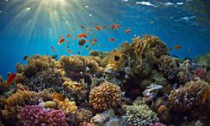
Scientists writing in the journal PLOS ONE say that if fish larvae were lost, they could just sniff their way back home. The study establishes that reef fish larvae can smell the presence of coral reefs from as far away as several miles offshore. The larvae are then able to use this scent to help guide themselves back home.
The researchers were aiming to study the response of cardnalfish and damselfish larvae in an open ocean setting using an outflow plume. The larvae were observed in the central chamber of an ocean Drifting In Situ Chamber (o-DISC), a device that is composed of a circular behavioral arena that is transparent to light, sound and small-scale turbulence.
The equipment was set up in the water column, and the swimming activity and bearing of the larvae was recorded using an underwater motion-sensing system. The o-DISC tracked larval movement and orientation using odor cues from the environment.
“In this collaborative study we expanded our work to demonstrate that the odor responses can also be detected under the field conditions,” Dr. Jelle Atema, Boston University Professor of Biology, said in a press release. “This establishes for the first time that reef fish larvae discriminate odor in situ.”
The scientists observed that cardinalfish tended to speed up their movement in response to odors in the plume, but their orientation toward the reef was not apparent. The researchers believe they were using sporadic odor cues in their attempt to orient themselves. By contrast, damselfish slowed their swim speed, and their orientation was along the shoreline and toward the west. They moved according to an internal compass, using the odor stimulus as a sort of ‘true north.’
“Ocean currents do not appear to influence the orientation of fish larvae,” Dr. Claire Paris, Professor at the University of Miami (UM) Rosenstiel School of Marine & Atmospheric Science, said in a press release. “They do not provide a frame of reference since larvae are transported within. Instead, we find that fish larvae navigate by detecting turbulent odor signals transported kilometers away from the reef. Subsequently they switch to a directional cue, perhaps magnetic or acoustic, which allows them to find the reef.”
This is the first study to find that fish larvae are able to use odor cues to navigate. Other fish, including maturesharks and salmon, are also able to navigate using olfactory signals.
“The implications of this study are tremendous, because we have to take into account the impact that human activities might have on the smells contained within the ocean. If these larvae cannot get their ‘wake up’ cues to orient back toward the reef they may stay out at sea and become easy prey before finding home,” said Paris.











Social Profiles